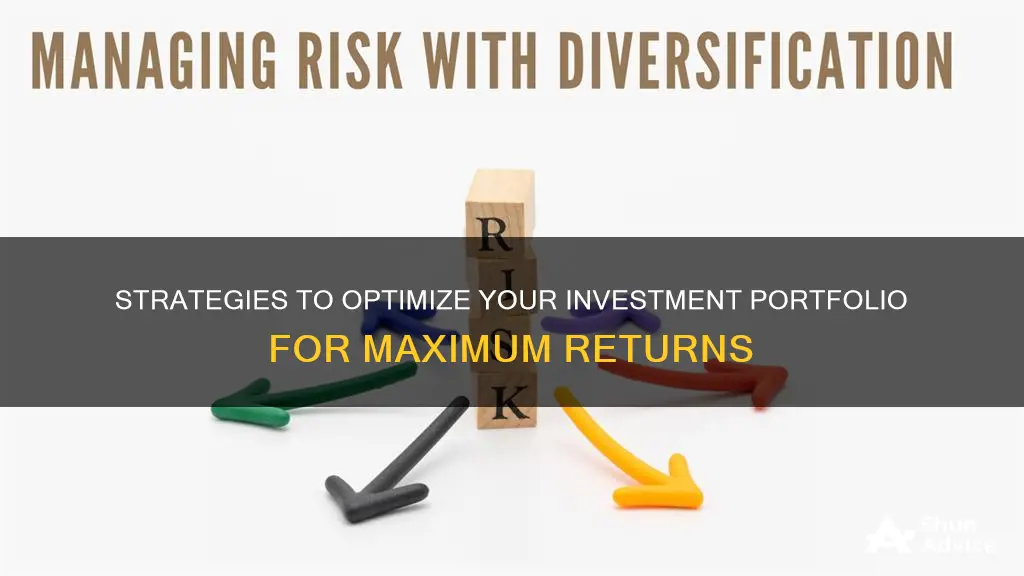
Portfolio optimisation is the process of selecting the best portfolio (asset distribution) from a set of considered portfolios, according to some objective. The objective typically involves maximising expected return while minimising financial risk. This process is based on modern portfolio theory (MPT), which argues that investments can generally be high risk/high reward or low risk/low reward. To minimise risk and maximise returns, investors should therefore choose a mix of both types of investments, in line with their personal risk tolerance.
This process is known as portfolio diversification, and it involves selecting asset classes and choosing assets within those classes. The optimal portfolio will have the highest Sharpe ratio, maximising profit relative to the risk taken.
What You'll Learn

Understand modern portfolio theory
Modern portfolio theory (MPT) is a practical method for selecting investments to maximise their overall returns within an acceptable level of risk. It was introduced in 1952 by American economist Harry Markowitz in his paper "Portfolio Selection", published in the Journal of Finance. Markowitz was later awarded a Nobel Prize for his work.
MPT is a mathematical framework used to build a portfolio of investments that maximises the amount of expected return for the collective given level of risk. A key component of the theory is diversification. Most investments are either high risk and high return or low risk and low return. Markowitz argued that investors could achieve their best results by choosing an optimal mix of the two based on their individual tolerance to risk.
MPT assumes that investors are risk-averse, meaning they prefer a less risky portfolio to a riskier one for a given level of return. As a result, most people should invest in multiple asset classes. The expected return of a portfolio is calculated as a weighted sum of the returns of the individual assets.
MPT uses the variance of return (or its transformation, the standard deviation) as a measure of risk because it is more manageable when combining assets into portfolios. The historical variance and covariance of returns are often used as a proxy for forward-looking versions of these quantities, but other more sophisticated methods are available.
MPT helps investors minimise market risk while maximising return. It starts with two fundamental assumptions:
- You cannot view assets in your portfolio in isolation. Instead, you must look at them as they relate to each other, both in terms of potential return and the level of risk each asset carries. When you look at a portfolio as an organic whole, you can select different assets whose performances aren't correlated to balance the risk offered by each choice.
- It is very difficult to forecast future investment returns. Instead, investors should look backwards at long-term historical returns to approximate how various investments might perform in the future.
With these principles in mind, investors proceed by modelling a range of different portfolios with varying levels of risk and expected returns.
Building a Solid Investment Portfolio: RIA Strategies
You may want to see also

Diversify your portfolio
Diversifying your portfolio is a crucial step in investment optimisation. The basic objective of diversification is to reduce risk. The old adage, "don't put all your eggs in one basket", rings true here. Diversification restricts the damage to your financial well-being in case one asset class or instrument takes a turn for the worse.
For example, during the 2008-9 financial crisis, equities crashed by 39%. If you were heavily invested in stocks and had a goal that matured that year, it would have been disastrous. However, if you had spread your investments across equity, debt, cash and gold, your portfolio would have still given a positive average return of 0.68%. This is because the losses in equities were offset by the stellar performance of gold (up 24%) and stable returns from debt and cash.
The situation reversed the following year, with equities rising by 94% while other asset classes lagged. Even so, a diversified portfolio still generated a respectable 27% return. This illustrates the power of diversification in smoothing out the volatility of individual asset classes and providing more stable, long-term returns.
- Understand the basics of asset classes: Familiarise yourself with the different types of asset classes such as equities, fixed income, money market, guaranteed and real estate. Each class has its own unique characteristics, risks and potential returns.
- Allocate your assets wisely: The general rule is to allocate more towards equities for long-term goals and more towards debt for short-term goals. Your age is a major factor in asset allocation. A common rule of thumb is the '100 minus your age' rule, which suggests that the percentage of stocks in your portfolio should be 100 minus your age. For example, a 30-year-old could keep 70% in stocks and 30% in bonds. As you get older, reduce your risk exposure by increasing the proportion of bonds in your portfolio.
- Consider your risk tolerance: Your willingness and ability to take on risk will influence your asset allocation. If you are risk-averse or have a low tolerance for losses, you may want to tilt your portfolio towards more stable, lower-risk investments like bonds. On the other hand, if you are comfortable with higher risk and potential losses, you may opt for a larger allocation of stocks.
- Invest across different industries: Avoid putting all your investments in a single sector, even if it is performing well. For instance, while the pharmaceuticals sector may be thriving due to the Covid-19 pandemic, diversifying into other sectors like education technology or information technology can help reduce risk and provide exposure to different areas of the economy.
- Rebalance your portfolio periodically: Regularly review the balance of your investment portfolio to ensure it aligns with your goals and milestones. A financial advisor can help with this process, providing discipline and insight into your investments.
- Consider global markets: Investing in international markets can offer the potential for high returns in a short time, but it also comes with additional risks and complexities. Exchange-traded funds (ETFs) or mutual funds are a good way to gain exposure to global markets with a small amount of capital.
- Invest in money market securities: Money market instruments, such as certificates of deposit (CDs), commercial papers (CPs), and treasury bills (T-bills), offer ease of liquidation and low risk. Treasury bills, backed by the central government, are particularly safe and ideal for short-term investments.
- Invest in bonds: Mutual funds with systematic cash flows, also known as systematic withdrawal plans (SWPs), allow you to access your money while it is locked in a savings plan. You can withdraw a fixed amount monthly or quarterly, providing liquidity and stability to your portfolio.
- Buy and hold: Avoid the temptation to constantly trade and instead, adopt a buy-and-hold strategy. This involves keeping a relatively stable portfolio, riding out market fluctuations, and allowing your investments to grow over the long term.
- Understand financial markets: Educate yourself on the factors that influence market movements, including interest rates, inflation, and central bank monetary policies. This knowledge will help you make more informed investment decisions.
- Consider life insurance: Investing in life insurance, especially at a young age, can provide peace of mind and safeguard your loved ones in the event of your untimely demise. Additionally, unit-linked insurance plans (ULIPs) combine life insurance with market-linked investments, offering the potential for returns along with insurance coverage.
- Be aware of your biases: Recognise the prejudices and ideas that may influence your investment decisions, such as risk aptitude, family attitude, cultural beliefs, and luck. Understanding these biases can help you make more rational and objective investment choices.
Saving and Investing: Your Guide to Financial Freedom
You may want to see also

Know your risk tolerance
Knowing your risk tolerance is a crucial aspect of optimising your investment portfolio. Risk tolerance refers to how much financial loss you can afford to bear and how much volatility you can handle emotionally. It is essential to understand your risk tolerance to build and optimise your investment portfolio effectively.
Risk tolerance is generally categorised into three levels: low, moderate, and high. High-tolerance investors are typically those who are mentally and financially capable of withstanding a significant level of loss. Younger investors, particularly those in their 20s, often fall into this category as they have more time to recoup any substantial capital losses before retirement. As investors approach retirement age, they usually become more risk-averse, opting for a more conservative investment strategy.
To determine your risk tolerance, it is advisable to consult a financial professional who can guide you through the process. Online risk tolerance calculators are also available to provide assistance. When assessing your risk tolerance, consider factors such as the current value of your investment portfolio, your monthly income and expenses, the timeline for your investments, and the amount of financial loss you can comfortably withstand.
Your risk tolerance will influence the types of assets you include in your portfolio. Regularly reviewing your risk tolerance is essential, as it may shift over time due to age, financial circumstances, or other significant life changes.
By understanding your risk tolerance, you can make informed decisions about the mix of investments in your portfolio, ensuring it aligns with your financial goals, risk appetite, and time horizon.
Savings or Investments: Open Economy, Open Question
You may want to see also

Set investment goals
Setting investment goals is a critical step in building a focused financial plan. It is important to define clear, specific, measurable, achievable, realistic, and time-based goals.
- Define your goals: Common financial goals include life events such as a wedding or vacation, retirement, funding emergency reserves, starting a family, and college funding. It is important to prioritize your goals based on your unique circumstances.
- Set SMART goals: Ensure your goals are Specific, Measurable, Achievable, Realistic, and Time-based. This framework will help you stay focused and track your progress.
- Figure out a strategy: Identify the main investment objectives, such as growth, preservation, cash flow, and lifestyle. This will help guide your investment choices and ensure they align with your goals.
- Set up an investment workflow: Create a written plan outlining your short-term and long-term goals. This could include reducing debt, starting an emergency fund, retirement planning, or saving for education. Review and adjust your plan regularly to ensure progress.
- Assign a timeline: Prioritize your goals based on their urgency. Some goals, like paying off high-interest credit card debt, require immediate funding, while others, like retirement, can be built over time.
- Determine savings requirements: Calculate how much you need to save annually to achieve your goals. For retirement, aim to save as much as possible, while for other goals, you can work backward from the target amount.
- Review and adjust: Investment goals are not set in stone. Regularly evaluate your progress, performance, and changing circumstances to ensure your goals remain realistic and achievable.
By setting clear and well-defined investment goals, you can create a roadmap to guide your financial decisions and increase the likelihood of achieving your desired outcomes.
National Savings, Investment, and Their Symbiotic Relationship
You may want to see also

Use a portfolio optimizer tool
Portfolio optimization is a complex process that involves selecting the best combination of investments to maximize returns while minimizing risk. Fortunately, there are portfolio optimizer tools that can help investors make sense of the data and build a strong investment portfolio. These tools are based on complex mathematical algorithms and financial models, and they take into account a wide range of variables, including market trends, historical data, asset correlations, and economic indicators.
One such tool is the Portfolio Optimizer Web API, which is based on the Nobel Prize-winning modern portfolio theory by Harry Markowitz. This tool is designed to be user-friendly, and it does not require any coding or mathematics expertise. It can be used directly from web pages, Microsoft Excel, or Google Sheets. The Portfolio Optimizer Web API allows users to compute the long-only minimum variance portfolio of assets with a given covariance matrix.
Another example of a portfolio optimizer tool is PortfoliosLab, which is designed for individual investors, financial advisors, and wealth managers. This tool utilizes advanced mathematical algorithms and financial models to generate optimal investment portfolios that balance desired returns with acceptable risk levels. It takes into account various factors, including market trends, historical data, asset correlations, and economic indicators, to provide a comprehensive analysis of a portfolio's performance.
When using a portfolio optimizer tool, it is important to consider your investment goals, risk tolerance, and investment horizon. These tools typically offer different optimization objectives, such as minimizing volatility, maximizing the Sharpe ratio, or focusing on risk parity. Choosing the right objective depends on your individual financial goals, risk appetite, and time frame for investing.
In addition to using portfolio optimizer tools, it is essential to have a solid understanding of asset classes and asset allocation. Familiarize yourself with the different types of assets, such as equities, fixed income, money market, guaranteed, and real estate. Asset allocation is a crucial aspect of portfolio optimization, as it helps you determine the right mix of investments to achieve your financial goals. By combining the use of portfolio optimizer tools with a strong foundation in investment knowledge, you can make more informed and strategic decisions to optimize your investment portfolio.
Investing: A Smarter Option Than Saving for Your Future
You may want to see also
Frequently asked questions
Portfolio optimization is the process of selecting the right set of assets to meet an investor's basic return objective, expected within a given time period, while incurring minimum cost and risk.
MPT, introduced by Harry Markowitz in 1952, argues that investments can generally be high risk/high reward or low risk/low reward. So, to minimize risk and maximize returns, investors should choose a mix of both types of investments, in line with their personal risk tolerance.
Diversification is a crucial principle in portfolio optimization. It involves spreading investments across different asset classes, industries, regions, etc., to reduce risk. By diversifying, investors benefit from the non-correlation or low correlation between foreign assets, as losses in some investments may be offset by gains in others.
Some common constraints include:
- Asset allocation limits: Setting upper and lower bounds on the percentage of the portfolio allocated to each asset.
- Budget constraint: Restricting the total investment amount available.
- Risk tolerance: Limiting the overall risk level of the portfolio, such as maximum acceptable volatility or drawdown.
Some widely used portfolio optimization strategies include:
- Mean-Variance Optimization: Finding the optimal risk-adjusted portfolio on the efficient frontier.
- Conditional Value-at-Risk: Minimizing expected tail loss.
- Risk Parity: Equalizing the risk contribution of portfolio assets.
- Tracking Error: Minimizing the tracking error against a selected benchmark.
- Kelly Criterion: Finding the portfolio with the maximum expected geometric growth rate.
- Sortino Ratio: Maximizing the Sortino ratio for a given minimum acceptable return.







